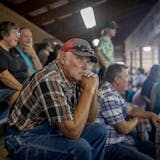A new custom-built high-rise featuring a sleek wood and metal design and breathtaking views of Como Lake hit the market Wednesday morning. Best of all? The list price is free — to bees and butterflies.
The pollinator "sky-rise" is the work of Public Art St. Paul and the Bee Lab at the University of Minnesota. The purpose of the striking yellow tower is more than artistic, however. Researchers hope to learn what kind of man-made housing will attract, protect and nurture pollinators at a time when natural habitat is disappearing.
At the same time, officials hope the tower and its nearby bins of free flower seeds — milkweed, purple prairie clover and black-eyed Susan — will elicit support for developing even more pollinator habitat.
It didn't take long Wednesday for a handful of bees from the nearby Shoreline Habitat Restoration Project to check out their potential new digs.
"I see a bee up in the bee house!" shouted Colleen Sheehy, executive director of Public Art St. Paul.
"I think they're excited for their urban house," said Amanda Lovelee, a lead artist on the project along with Christine Baeumler and Julie Benda.
The sky-rise was funded with $113,000 from the Knight Foundation, as well as money the city of St. Paul set aside to develop public art.
The project will last three years and cost $300,000 total, Sheehy said. In addition, a $245,000 Minnesota Futures Grant from the U will help researchers test the bee house's design, use and effectiveness.


